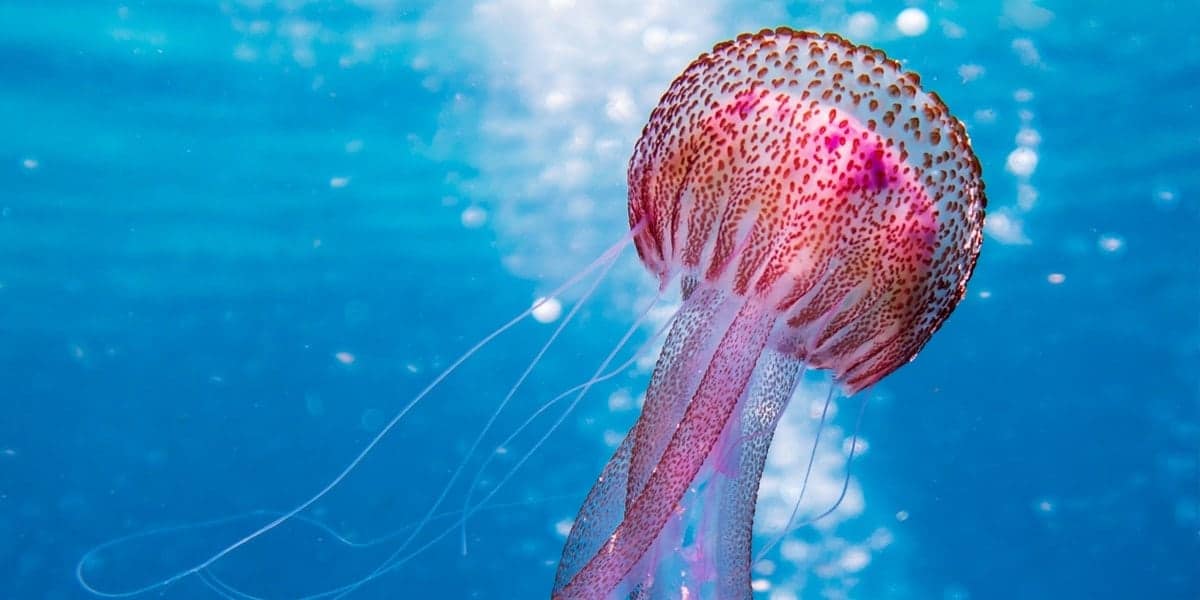There are two schools of thought when it comes to jellyfish. When seen in an aquarium, like the fabulous Maui Ocean Center, they are stunningly beautiful. Watching them glow and glide is a sight to behold. On the other hand, when you're wading waist deep in the ocean and spot a jellyfish, your first thought is usually to high tail it out of the water like you've just seen Jaws. It's true the sting of some jellyfish can be nasty. Generally, though, Maui's waters are pretty clear of the largest stinging jellies. On the Hawaii Ocean Project Lanai Snorkel and Dolphin Tour, we avoid snorkel locations with stinging jellyfish. Here are 10 fun facts about jellyfish...
- There are three main types of jellyfish in Hawaii:
a. Box jellyfish: The box jelly looks like a bit like a bell. Their bodies are roughly 1-to-3 inches in length, with stinging tentacles that can reach up to two feet long. You will definitely feel the sting of a box jellyfish and they should be avoided if at all possible. In fact, in severe cases, the sting of a box jelly, though rare, can be fatal. To be fair, the box jellies of Hawaii are less lethal than their counterparts found elsewhere in the world. When a bloom of box jellies approaches the beach, lifeguards will generally shut the beach down. So, if you're visiting any of Hawaii's popular beaches with lifeguards, you can confidently enter the water and not be concerned about running into one.
b. Moon jellyfish: Though they can grow to a diameter of 10-to-16 inches, moon jellyfish have only mild stinging cells. If the box jellyfish is similar to a bee sting, the moon jellyfish is more like a mild, ant bite. You may feel it, but it doesn't hurt.
c. Spotted jellyfish: Another bell-shaped jelly, the spotted jellyfish are usually gold in color and grow up to 12" in diameter, though the average size is about 4 inches. One curious fact about these jellyfish is they have multiple mouths on their arms for capturing the small plankton they dine on. Though they do have stingers, the venom is so mild that it does not cause problems for humans.
- The Portuguese Man-O'-War is not technically a jellyfish, but it sure looks like a jellyfish and its sting packs a wallop. Man-o'-wars cannot swim. Instead, their bodies are basically two-inch bubbles that allow them to sail wherever the wind pushes them. While their bodies are only 2" in diameter, their tentacles can reach up to 30 feet!
- A group of jellyfish are called blooms, swarms or smacks. A large bloom can have over 100,000 jellyfish!
- Jellyfish have been around for millions of years. They predate dinosaurs.
- Jellyfish have a potty mouth. While the spotted jellyfish have small mouths on their arms, the main mouths of jellyfish are found in the center of their bodies. They don't only use their mouths for ingesting food, but they expel waste from the same opening. Jellyfish can also use their mouths to propel themselves.
- If you plan on keeping a jellyfish as a pet, you're out of luck, or you'll be in a perpetual state of sadness. The lifespan of a jellyfish is incredibly short. Some smaller jellyfish live for mere hours. While other jellies can live up to a year, most only last for a few days or weeks.
- Jellyfish can clone themselves. Yep, as if their ghost-like appearance wasn't creepy enough, if a jelly is cut into two pieces, the jellyfish can regenerate itself and form two distinct creatures.
- Jellyfish are like zombies... they don't have brains! OK, now it's getting downright scary. Instead of brains, they have nerve nets that sense changes in their environment and direct their reactions. Additionally, jellyfish don't have hearts, bones or eyes.
- You remember when we said jellyfish had short life spans? Well, in one way, some jellyfish are immortal. Yes, it seems like jellyfish are built to survive the zombie apocalypse! Here's how the immortality-thing works. Jellyfish start as simple polyps, before "blooming" their (beautiful) outer membranes, called medusas. But in times of stress, some jellyfish can reverse their growth back to the polyp stage, then start their lives all over again once things resume back to normal. Crazy!
- No, you shouldn't pee on a jellyfish sting. Phew. Here's what you should actually do. First, no matter what Google says, do NOT try to scrape away the tentacles. By doing so, you will actually release more venom. Instead, try pouring vinegar on the sting. The vinegar will neutralize the stingers. Then, and only then, should you remove the tentacles. This information was published in a report by the University of Hawaii in 2017. If you're looking for a commercial product to ease the sting, Popular Science recommends Sting No More.
By the way, did you know that you can now save $10/person on our Maui Princess Dinner Cruise or a Snorkel Adventure to the Island of Lanai? Well you can! Just use the promocode VIP20 after clicking on this link: Hawaii Ocean Project Adventures.

